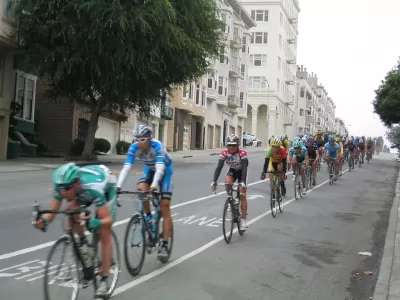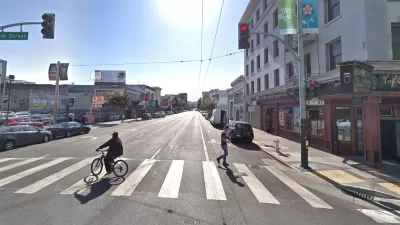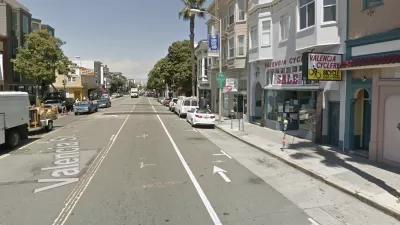Street improvements to benefit cyclists and pedestrians have been moving rapidly in San Francisco since the June approval of the Vision Zero quick-build initiative, a two-year plan to expedite safety project on high-injury corridors.

"A street design revolution is under way in San Francisco’s downtown and waterfront neighborhoods, the bustling heart of the city and the site of many deadly car crashes," writes Rachel Swan, who covers transportation for the San Francisco Chronicle.
The frenzy of quick-build projects represents a culture change at San Francisco Municipal Transportation Agency [SFMTA], long known for its sluggish bureaucracy and inability to overcome political opposition.
"Quick-build projects are reversible, adjustable traffic safety improvements that can be installed relatively quickly," states the SFMTA description of the initiative at the heart of the street design revolution. See slide presentation [pdf].
Unlike major capital projects that may take years to plan, design, bid and construct, quick-build projects are buildable within weeks and months and are intended to be evaluated and reviewed within the initial 24 months of construction.
"In past years, infrastructure as simple as a raised crosswalk or a paint-and-post bike lane would run through a gantlet of community meetings, where residents and merchants would rail about lost parking or the narrowing of a road," adds Swan.
Sometimes neighbors would kill a project all together. Often they would slow it down or significantly alter the plans.
Conversion of conventional to protected bike lane
"And this week [Sept. 17] the board of directors for the SFMTA unanimously approved another protected bike lane along Fifth Street, stretching from Caltrain to Market Street," adds Swan.
On average one person gets injured each week in traffic collisions on Fifth Street, a disturbing trend that the SFMTA hopes to reverse, said agency planner Thalia Leng.
Crews will begin re-striping the street within six weeks, finish concrete work next winter and upgrade intersections in 2021.
The 5th Street Improvement Project fits in well with the Vision Zero Quick-Build initiative in the sense that rather than adding a new, protected bike lane, which would make it more of a long term capital improvement project, SFMTA will upgrade the existing conventional bike lane to a protected lane.
“As it currently exists, 5th Street is simply not designed to keep pedestrians and bicyclists safe," said Mayor London Breed in a news release on Sept. 18.
"This project will protect pedestrians and bicyclists, and our new quick-build policy will allow us to make immediate safety improvements while long-term changes are being made.”
A good example of the MTA turnaround in approaching deadly corridors is the Townsend Corridor Improvement Project by the San Francisco Caltrain Depot, which was shelved last year and is now undergoing construction.
The 7th Street Safety Project was completed last month and is operational, but a critical commentary by Streetsblog SF editor Roger Rudick highlights the differences between the quick-build approach to protected bike lanes and those done as long term capital improvements.
Related in Planetizen:
-
Streamlining Protected Bike Lanes, San Francisco Style, June 4, 2019
-
It Takes a Fatality to Remove On-Street Parking, March 15, 2019
-
Dangerous By Design: Streets Are Only Getting Less Safe for Pedestrians, January 23, 2019
-
Protected Bike Lane Plan Shelved in San Francisco, July 13, 2018
-
Court Ruling Stalls San Francisco Bike Plan, November 10, 2006
FULL STORY: Protected bike lanes approved for Fifth Street, work to begin within 6 weeks

Maui's Vacation Rental Debate Turns Ugly
Verbal attacks, misinformation campaigns and fistfights plague a high-stakes debate to convert thousands of vacation rentals into long-term housing.

Planetizen Federal Action Tracker
A weekly monitor of how Trump’s orders and actions are impacting planners and planning in America.

In Urban Planning, AI Prompting Could be the New Design Thinking
Creativity has long been key to great urban design. What if we see AI as our new creative partner?

King County Supportive Housing Program Offers Hope for Unhoused Residents
The county is taking a ‘Housing First’ approach that prioritizes getting people into housing, then offering wraparound supportive services.

Researchers Use AI to Get Clearer Picture of US Housing
Analysts are using artificial intelligence to supercharge their research by allowing them to comb through data faster. Though these AI tools can be error prone, they save time and housing researchers are optimistic about the future.

Making Shared Micromobility More Inclusive
Cities and shared mobility system operators can do more to include people with disabilities in planning and operations, per a new report.
Urban Design for Planners 1: Software Tools
This six-course series explores essential urban design concepts using open source software and equips planners with the tools they need to participate fully in the urban design process.
Planning for Universal Design
Learn the tools for implementing Universal Design in planning regulations.
planning NEXT
Appalachian Highlands Housing Partners
Gallatin County Department of Planning & Community Development
Mpact (founded as Rail~Volution)
City of Camden Redevelopment Agency
City of Astoria
City of Portland
City of Laramie




























